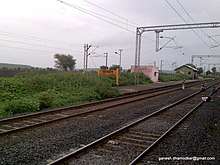Malkheda
Malkheda, also known as Malkhed,[1][2]) is a town in Karnataka, India. It is located on the banks of Kagina River in Sedam Taluk of Gulbarga district, around 40 km from Kalaburagi.
Malkheda Malkheda Manyakheta | |
|---|---|
village | |
| Nickname(s): Malkheda;Manyakheta | |
 Malkheda Location in Karnataka, India  Malkheda Malkheda (India) | |
| Coordinates: 17°11′42″N 77°9′39″E | |
| Country | |
| State | Karnataka |
| District | Kalaburagi district |
| Taluk | Sedam |
| Lok Sabha Constituency | Gulbarga |
| Government | |
| • Type | Gram |
| • Body | Panchayat of Malkheda |
| Population (2001) | |
| • Total | 11,180 |
| Languages | |
| • Official | Kannada |
| Time zone | UTC+5:30 (IST) |
| PIN CODE | 585 317 |
| Vehicle registration | KA 32 |
Originally known as Manyakheta (IAST: Mānyakheṭa, "Mannakheḍa" in Prakrit), it was the capital of the Rashtrakuta dynasty during 9th and 10th centuries. At Malkhed, there is historical Fort, the Restoration of the Fort is in progress based on a proposal submitted by HKADB (Hyderabad Karnataka Area Development Board).
Demographics
As of 2001 India census, Malkhed had a population of 11,180 with 5,679 males and 5,501 females and 2,180 households.[3]
History
Manyakheta rose to prominence when the capital of Rashtrakutas was moved from Mayurkhandi in Bidar district to Mānyakheṭa during the rule of Amoghavarsha I. After the fall of the Rāṣṭrakūṭas, it remained the capital of their successors, the Kalyani Chalukyas or Western Chalukyas till about 1050 CE. According to Dhanapāla's Pāiyalacchi, the city was sacked by the Paramāra king Harṣa Sīyaka in CE 972-73, the year he completed that work.[4]
Malkhed is home to two ancient institutions.
- The Uttaradi Matha of the Dwaita School of philosophy of Madhvacharya. The remains of one of its most prominent saints, Sri Jayatirtha's Mula Brindavana is here. He was a commentator of the celebrated "aNuvyakhyana" of Madhvacharya which itself is a commentary upon the "Brahma Sutras". For this commentary called Nyaya Sudha, he is popularly known as Teekacharya.
- The Jain Bhattaraka Math. The temple of Neminath (9th century AD). The pillars and walls of the temple date back to between the 9th and 11th centuries. The idols include tirthankaras, choubisi (24 tirthankaras), Nandishwar dvipa and idols of yakshi. There is a famous panchdhatu shrine with 96 images. In the same temple, there are other historical images. The last bhaṭṭāraka of the Malkhed seat who reigned during the year 1950–61, was Bhaṭṭāraka Devendrakīrti.[5]
The famous Mahapurana (Adipurana and Uttarapurana) was composed here by Acharya Jinasena and his pupil Gunabhadra in the 9th century. Somodeva Suri's Yasastilaka Champu was written here. The mathematics text Ganita Saara Sangraha was written here by Mahaviracharya.
The famous Apabhramsha poet Pushapadanta lived here.
From 814 AD to 968 AD Manyakheta rose to prominence when The capital of Rashtrakutas was moved from Mayurkhandi in Bidar district to Mānyakheṭa during the rule of Amoghavarsha I (Nrupatunga Amoghavarsha), ruled for 64 years and wrote Kavirajamarga the first classical Kannada work. Amoghavarsha I and the scholars mathematician Mahaveeracharya, and intellectuals Ajitasenacharya, Gunabhadracharya and Jinasenacharya, he helped to spread Jainism. According to Dhanapāla's Pāiyalacchi, the city was sacked by the Paramāra king Harṣa Sīyaka in 972–73 CE, the year he completed that work.[6] After the fall of the Rāṣṭrakūṭas, it remained the capital of their successors, the Kalyani Chalukyas or Western Chalukyas till about 1050 CE. It was later ruled by Kalyani Chalukyas, Southern Kalachuris, Yadavas, Kakatiyas, Delhi Sultanate, Bahmani Sultanate, Bidar Sultanate, Bijapur Sultanate, Mughal Empire and Nizam of Hyderabad by 1948.
Economy

Malkhed is the home to one of the biggest cement factories by name Rajashree Cements owned by the Aditya Birla Group. The village is now developing into a business centre for food grains, dairy and livestock trading . Malkhed has got the biggest livestock trading centre in the entire region. The main crops grown here are mostly rainfed crops like different varieties of pulses pigeonpea, greengram, blackgram. Though water is plenty, it is rarely utilised for agriculture.The masonry here in Malkhed is basically stone masonry and the thatching of the roofs are done by square blocks of stone which are placed in a slanting way so that the rain water gets easily drained off.
Transport
Malkheda is well connected by road and railway. Malkheda lies in State Highway 10. Malkaheda is 40 km southeast to the District Headquarters Gulbarga and 18 km west to the Taluk Headquarters Sedam. There is also a railway station in the village.
References
- Village code= 311400 "Census of India : Villages with population 5000 & above". Registrar General & Census Commissioner, India. Archived from the original on 8 December 2008. Retrieved 18 December 2008.
- "Yahoomaps India :". Archived from the original on 18 December 2008. Retrieved 8 December 2008. Malkhed (J), Gulbarga, Karnataka
- "Census of India: View Population Details". Censusindia.gov.in. Retrieved 20 January 2013.
- Georg Bühler, 'Pâiyalachchhî Nâmamâlâ', in Beiträge zur Kunde der Indogermanischen Sprachen, vol. 4, edited by Adalbert Bezzenberger (Göttingen, 1878) and B. J. Dośī, Pāia-lacchīnāmamāla (Prākṛta-Lakṣmināmamālā) (Bombay, 1960): v. 276
- [https://www.soas.ac.uk/jainastudies/newsletter/file119532.pdf A Rare Letter of a Bhaṭṭāraka of Malayādri (=Malayakheḍa>Malkhed) Padmanabh S. Jaini, CoJS Newsletter, March 2017, Issue 12, pp. 28-33]
- Georg Bühler, 'Pâiyalachchhî Nâmamâlâ', in Beiträge zur Kunde der Indogermanischen Sprachen, vol. 4, edited by Adalbert Bezzenberger (Göttingen, 1878) and B. J. Dośī, Pāia-lacchīnāmamāla (Prākṛta-Lakṣmināmamālā) (Bombay, 1960): v. 276
- "Census of India: View Population Details". Censusindia.gov.in. Retrieved 20 January 2013.
- Dr. Suryanath U. Kamath (2001). A Concise History of Karnataka from pre-historic times to the present, Jupiter books, MCC, Bangalore (Reprinted 2002) OCLC: 7796041